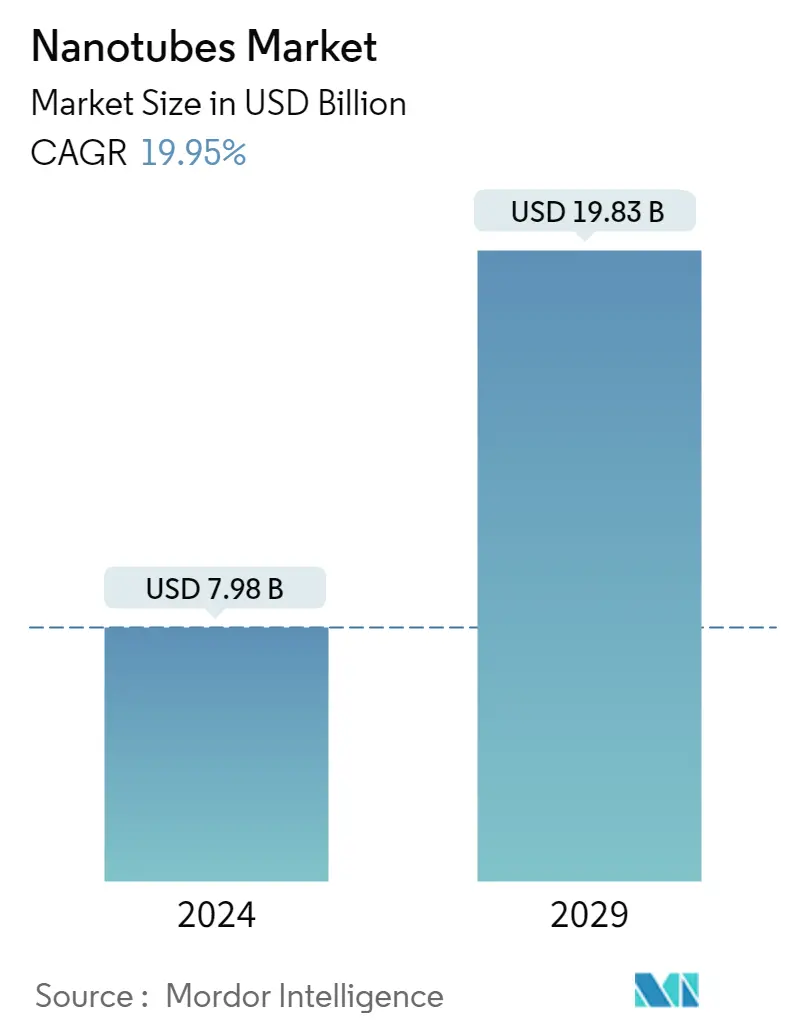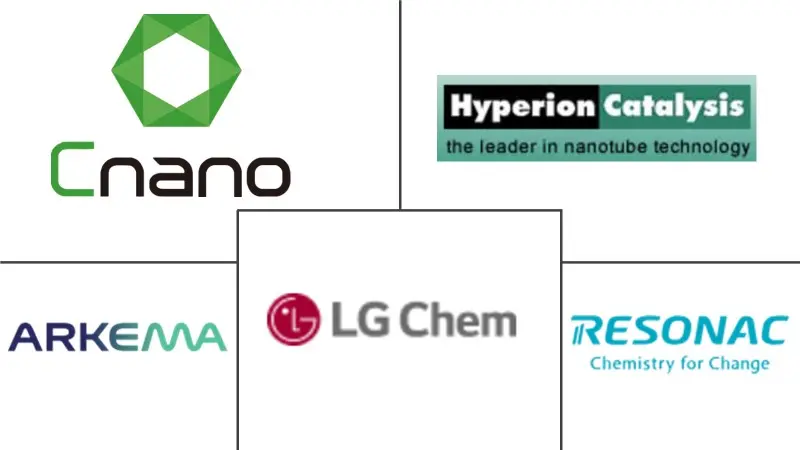Market Size of Nanotubes Industry

| Study Period | 2019 - 2029 |
| Market Size (2024) | USD 7.98 Billion |
| Market Size (2029) | USD 19.83 Billion |
| CAGR (2024 - 2029) | 19.95 % |
| Fastest Growing Market | Asia Pacific |
| Largest Market | Asia Pacific |
Major Players
*Disclaimer: Major Players sorted in no particular order |
Nanotubes Market Analysis
The Nanotubes Market size is estimated at USD 7.98 billion in 2024, and is expected to reach USD 19.83 billion by 2029, growing at a CAGR of 19.95% during the forecast period (2024-2029).
The nanotubes market was negatively impacted by the COVID-19 pandemic as there was a slowdown in production and mobility, which caused a shortage of semiconductors, which negatively impacted the market for nanotubes. Also, industries such as electronics, energy, and aerospace were forced to delay their production due to containment measures and economic disruptions. Currently, the market has recovered from the pandemic. The market reached pre-pandemic levels in 2022 and is expected to grow steadily in the future.
The major factors driving the growth of the market studied are an advancement in nanotube technologies and the growing adoption of carbon nanotubes.
On the flip side, high manufacturing and R&D costs serve as one of the major stumbling blocks in the growth of the market studied.
Rising potential uses in electronic and storage devices are likely to provide opportunities for the market studied during the forecast period.
Asia-Pacific dominated the global market, as the increasing application and demand from industries such as electronics, energy, aerospace, and defense majorly drive the demand for nanotubes.
Nanotubes Industry Segmentation
Nanotubes are small cylinders of atoms that are generally used for a wide range of applications owing to their electrical and mechanical properties. Different nanotubes have insulating, conducting, and semiconducting properties; among these, carbon nanotubes are mostly used. Carbon nanotubes have semiconductor properties that provide small transistors with high switching speeds, low electrical resistance, etc.
The nanotubes market is segmented by type, structure type, application, end-user industry, and geography. By type, the market is segmented into carbon nanotubes, silicon nanotubes, inorganic nanotubes, and other types (membrane nanotubes, etc.). By structure type, the market is segmented into non-polymer organic nanomaterials and polymeric nanomaterials. By application, the market is segmented into hydrogen storage devices, sensors, polymeric biomaterials, Li-ion batteries, luminescent display devices, biosensors, nanoelectrodes, water purification filters, semiconductor devices, and conductive plastics. By end-user industry, the market is segmented into healthcare, electronics, energy, automotive, aerospace and defense, textile, and other end-user industries (chemical materials, etc.). The report also covers the market size and forecasts for the market in 15 countries across the globe.
For each segment, the market sizing and forecasts have been done on the basis of value (USD).
| Type | |
| Carbon Nanotubes | |
| Silicon Nanotubes | |
| Inorganic Nanotubes | |
| Other Types (Membrane Nanotubes, Etc.) |
| Structure Type | |
| Non-polymer Organic Nanomaterials | |
| Polymeric Nanomaterials |
| Application | |
| Hydrogen Storage Devices | |
| Sensors | |
| Polymeric Biomaterials | |
| Li-ion Batteries | |
| Luminescent Display Devices | |
| Biosensors | |
| Nanoelectrodes | |
| Water Purification Filters | |
| Semiconductor Devices | |
| Conductive Plastics |
| End-user Industry | |
| Healthcare | |
| Electronics | |
| Energy | |
| Automotive | |
| Aerospace and Defense | |
| Textile | |
| Other End-user Industries (Chemical Materials, Etc.) |
| Geography | |||||||
| |||||||
| |||||||
| |||||||
| |||||||
|
Nanotubes Market Size Summary
The nanotubes market is poised for significant growth, driven by advancements in nanotube technologies and the increasing adoption of carbon nanotubes across various industries. The market, which experienced a downturn due to the COVID-19 pandemic, has rebounded to pre-pandemic levels and is expected to expand steadily. The electronics industry, in particular, is a major contributor to this growth, with nanotubes being utilized in the development of faster and more efficient electronic devices. Carbon nanotubes, in particular, are in high demand due to their diverse applications in displays, sensors, and other electronic components. Despite the high manufacturing and R&D costs posing challenges, the rising potential uses in electronic and storage devices present lucrative opportunities for market expansion.
The Asia-Pacific region dominates the global nanotubes market, fueled by robust demand from sectors such as electronics, energy, healthcare, aerospace, defense, and automotive. Countries like Japan, China, and India are key players, with significant contributions from their electronics and automotive industries. The region's growth is further supported by policy developments and infrastructure investments aimed at enhancing manufacturing capabilities and supply chain efficiencies. The fragmented nature of the market sees major players like Arkema, Hyperion Catalysis International, and LG Chem actively expanding their production capacities and strategic acquisitions, such as Birla Carbon's acquisition of Nanocyl SA, to strengthen their market positions.
Nanotubes Market Size - Table of Contents
-
1. MARKET DYNAMICS
-
1.1 Drivers
-
1.1.1 Advancement in Nanotubes Technologies
-
1.1.2 Growing Adoption of Carbon Nanotubes
-
1.1.3 Other Drivers
-
-
1.2 Restraints
-
1.2.1 High Manufacturing and R&D Cost
-
1.2.2 Other Restraints
-
-
1.3 Industry Value Chain Analysis
-
1.4 Porter's Five Forces Analysis
-
1.4.1 Bargaining Power of Suppliers
-
1.4.2 Bargaining Power of Buyers
-
1.4.3 Threat of Substitute Products and Services
-
1.4.4 Threat of New Entrants
-
1.4.5 Degree of Competition
-
-
-
2. MARKET SEGMENTATION (Market Size in Value)
-
2.1 Type
-
2.1.1 Carbon Nanotubes
-
2.1.2 Silicon Nanotubes
-
2.1.3 Inorganic Nanotubes
-
2.1.4 Other Types (Membrane Nanotubes, Etc.)
-
-
2.2 Structure Type
-
2.2.1 Non-polymer Organic Nanomaterials
-
2.2.2 Polymeric Nanomaterials
-
-
2.3 Application
-
2.3.1 Hydrogen Storage Devices
-
2.3.2 Sensors
-
2.3.3 Polymeric Biomaterials
-
2.3.4 Li-ion Batteries
-
2.3.5 Luminescent Display Devices
-
2.3.6 Biosensors
-
2.3.7 Nanoelectrodes
-
2.3.8 Water Purification Filters
-
2.3.9 Semiconductor Devices
-
2.3.10 Conductive Plastics
-
-
2.4 End-user Industry
-
2.4.1 Healthcare
-
2.4.2 Electronics
-
2.4.3 Energy
-
2.4.4 Automotive
-
2.4.5 Aerospace and Defense
-
2.4.6 Textile
-
2.4.7 Other End-user Industries (Chemical Materials, Etc.)
-
-
2.5 Geography
-
2.5.1 Asia-Pacific
-
2.5.1.1 China
-
2.5.1.2 India
-
2.5.1.3 Japan
-
2.5.1.4 South Korea
-
2.5.1.5 Rest of Asia-Pacific
-
-
2.5.2 North America
-
2.5.2.1 United States
-
2.5.2.2 Canada
-
2.5.2.3 Mexico
-
-
2.5.3 Europe
-
2.5.3.1 Germany
-
2.5.3.2 United Kingdom
-
2.5.3.3 France
-
2.5.3.4 Italy
-
2.5.3.5 Rest of Europe
-
-
2.5.4 South America
-
2.5.4.1 Brazil
-
2.5.4.2 Argentina
-
2.5.4.3 Rest of South America
-
-
2.5.5 Middle-East and Africa
-
2.5.5.1 Saudi Arabia
-
2.5.5.2 South Africa
-
2.5.5.3 Rest of Middle-East and Africa
-
-
-
Nanotubes Market Size FAQs
How big is the Nanotubes Market?
The Nanotubes Market size is expected to reach USD 7.98 billion in 2024 and grow at a CAGR of 19.95% to reach USD 19.83 billion by 2029.
What is the current Nanotubes Market size?
In 2024, the Nanotubes Market size is expected to reach USD 7.98 billion.

